Dr. Myron W. Evans (Books)
 View count:
View count: 1
by Myron W. Evans
Pages: 292
Publisher: Abramis
Year: 2007
ISBN: 184549248X
ISBN: 978-1845492489
This book is the first to describe a very successful objective unified field theory which emerged in 2003 and which is already mainstream physics - Einstein Cartan Evans (ECE) field theory. The latter completes the well known work of Einstein and Cartan, who from 1925 to 1955 sought to unify field theory in physics with the principles of general relativity. These principles are based on the need for objectivity in natural philosophy, were first suggested by Francis Bacon in the sixteenth century and developed into general relativity in about 1915. In this year, using Riemann geometry, Einstein and Hilbert independently arrived at an objective field equation for gravitation. Since then there have been many attempts to unify the 1915 gravitational theory with the other three fundamental fields: electromagnetism, the weak and strong fields.In this volume four further topics in the Einstein Cartan Evans unified field theory are covered, namely dynamics, geodesics, the Aharonov Bohm effects, quantum field theory, light deflection by gravitation, the spin connection in the Coulomb law, the ECE Lemma, spin connection resonance and applications to new energy, spin connection resonance in gravitation, the vector boson nature of the electric field, the gravitational equivalent of the Faraday law of induction, and the effect of gravitation on radiatively induced fermion resonance (RFR).
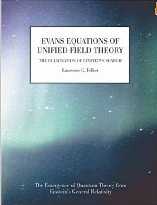 View count:
View count: 1
by Myron W. Evans
Pages: 388
Publisher: Abramis
Year: 2007
ISBN: 1845492145
Einstein was Right! Quantum Mechanics and General Relativity are the two main theories of physics that describe the universe in which we live. Attempts at combining them have been made since the 1920's with no success. Albert Einstein spent much of his later years searching for the key to unification. He never fully accepted quantum theory and maintained it was incomplete. Quantum theory has supplied answers to questions involving basic particles and electromagnetism. Relativity has explained gravity and the unity of space and time. However, the two have not, until Evans developed a new paradigm and the equations to prove it, been combined. Einstein showed that gravitation is the curving of spacetime, not an attractive force between masses. Evans has showed that electromagnetism is the spinning of spacetime. It is not a force superimposed upon the spacetime rather it is a property of spacetime itself. Using Cartan differential geometry, Evans describes Einstein's gravitation and quantum electromagnetics in the same equations. All the basic equations of physics emerge from General Relativity using Cartan's geometry.This book describes the basics of special relativity, quantum mechanics, general relativity, and the geometry used to describe them. Then it details the basics of Evans' discoveries and their implications. Laurence G. Felker is a controls engineer and has studied physics for his whole professional career. His previous published work has been in technical journals and this is his first physics book.
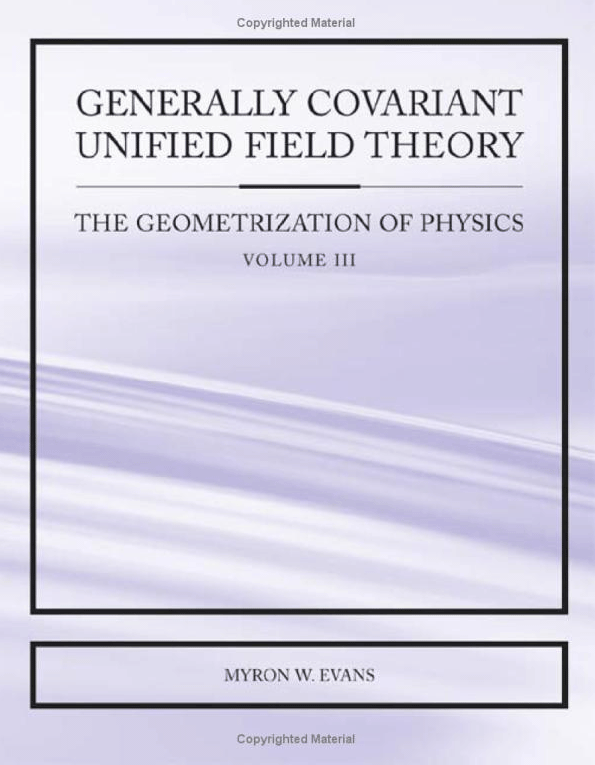 View count:
View count: 1
This book is the first to describe a very successful objective unified field theory which emerged in 2003 and which is already mainstream physics - Einstein Cartan Evans (ECE) field theory. The latter completes the well known work of Einstein and Cartan, who from 1925 to 1955 sought to unify field theory in physics with the principles of general relativity. These principles are based on the need for objectivity in natural philosophy, were first suggested by Francis Bacon in the sixteenth century and developed into general relativity in about 1915. In this year, using Riemann geometry, Einstein and Hilbert independently arrived at an objective field equation for gravitation.Since then there have been many attempts to unify the 1915 gravitational theory with the other three fundamental fields: electromagnetism, the weak and strong fields. As described for the first time in this book, unification is achieved straightforwardly with the principles of standard Cartan geometry and the Evans Ansatz. The latter shows that electromagnetism is spinning spacetime, gravitation is curving spacetime and that they are unified with the structure (or master) equations of Cartan. Quantum mechanics is unified with general relativity using the Evans Lemma and wave equation.Technical appendices and charts are provided which show how all the major equations of physics are obtained from the ECE field theory and two introductory chapters describe the background mathematics from an elementary level. In this third volume, ECE theory is extended to the Sagnac effect and Faraday disc generator to show that electrodynamics is spinning space-time in general relativity. These two effects are difficult to explain with special relativity. A simplified dielectric ECE theory is developed and applied for example to cosmology.One chapter is dedicated to a convenient summary of all the details of Cartan geometry needed to develop ECE theory. The important topic of spin connection resonance (SCR) is introduced and applied to new energy and counter-gravitation. Finally wave mechanics is developed in ECE theory.
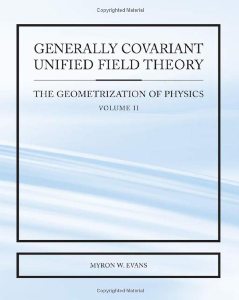 View count:
View count: 1
This book is the first to describe a very successful objective unified field theory which emerged in 2003 and which is already mainstream physics - Einstein Cartan Evans (ECE) field theory. The latter completes the well known work of Einstein and Cartan, who from 1925 to 1955 sought to unify field theory in physics with the principles of general relativity. These principles are based on the need for objectivity in natural philosophy, were first suggested by Francis Bacon in the sixteenth century and developed into general relativity in about 1915. In this year, using Riemann geometry, Einstein and Hilbert independently arrived at an objective field equation for gravitation. Since then there have been many attempts to unify the 1915 gravitational theory with the other three fundamental fields: electromagnetism, the weak and strong fields. As described for the first time in this book, unification is achieved straightforwardly with the principles of standard Cartan geometry and the Evans Ansatz. The latter shows that electromagnetism is spinning spacetime, gravitation is curving spacetime and that they are unified with the structure (or master) equations of Cartan. Quantum mechanics is unified with general relativity using the Evans Lemma and wave equation. Technical appendices and charts are provided which show how all the major equations of physics are obtained from the ECE field theory and two introductory chapters describe the background mathematics from an elementary level. The mathematical structure of ECE field theory is standard Cartan geometry, also known as differential geometry. The main topics of contemporary physics are covered in individual chapters, which also describe the conditions under which ECE theory reduces to Einstein Hilbert (EH) theory, and to Maxwell Heaviside field theory in classical electrodynamics. The Dirac equation is derived as a limit of the wave equation of ECE theory. The Schrodinger and Newton equations then follow as limits of the Dirac equation. It is therefore shown that ECE field theory provides, for the first time, a structure for the objective unification of field theory in natural philosophy. - Amazon
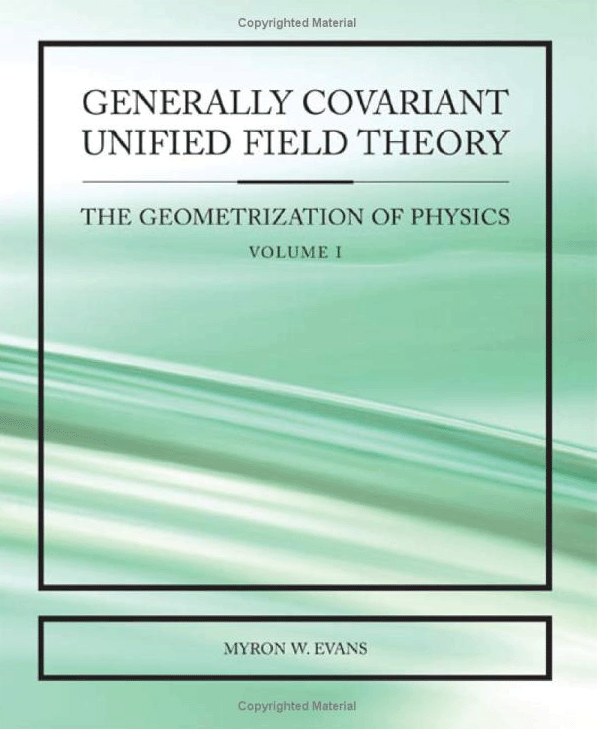 View count:
View count: 1
This book is the first to describe a very successful objective unified field theory which emerged in 2003 and which is already mainstream physics - Einstein Cartan Evans (ECE) field theory. The latter completes the well known work of Einstein and Cartan, who from 1925 to 1955 sought to unify field theory in physics with the principles of general relativity. These principles are based on the need for objectivity in natural philosophy, were first suggested by Francis Bacon in the sixteenth century and developed into general relativity in about 1915. In this year, using Riemann geometry, Einstein and Hilbert independently arrived at an objective field equation for gravitation. Since then there have been many attempts to unify the 1915 gravitational theory with the other three fundamental fields: electromagnetism, the weak and strong fields. As described for the first time in this book, unification is achieved straightforwardly with the principles of standard Cartan geometry and the Evans Ansatz. The latter shows that electromagnetism is spinning spacetime, gravitation is curving spacetime and that they are unified with the structure (or master) equations of Cartan. Quantum mechanics is unified with general relativity using the Evans Lemma and wave equation. Technical appendices and charts are provided which show how all the major equations of physics are obtained from the ECE field theory, and two introductory chapers describe the background mathematics from an elementary level. The mathematical structure of ECE field theory is standard Cartan geometry, also known as differential geometry. The main topics of contemporary physics are covered in individual chapters, which also describe the conditions under which ECE theory reduces to Einstein Hilbert (EH) theory, and to Maxwell Heaviside field theory in classical electrodynamics. The Dirac equation is derived as a limit of the wave equation of ECE theory. The Schrodinger and Newton equations then follow as limits of the Dirac equation. It is therefore shown that ECE field theory provides, for the first time, a structure for the objective unification of field theory in natural philosophy.
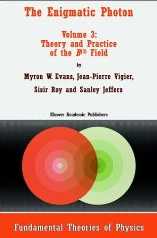 View count:
View count: 1
Volume 3 of The Enigmatic Photon develops the theory and practical applications of the B(3) field. The opening chapters are based on the Dirac equation of a single fermion in a circularly-polarized electromagnetic field, an equation which defines the way in which B(3) interacts with matter. These chapters predict the theoretical possibility of nuclear magnetic resonance at infrared and visible frequencies. The third chapter considers the optical Aharonov--Bohm effect due to B(3), and suggests a mechanism for action at a distance in electrodynamics. Subsequent chapters discuss the radiation theory of B(3) and relate it to the theory of fine photon mass. The final two chapters treat the theory of B(3) in cosmology and summarize future experimental developments. This book is a sequel to Volume 1, The Field B(3), which presents the first systematic description of the fundamental magnetizing field of electromagnetic radiation and Volume 2, Non-Abelian Electrodynamics, which deals with the development of the theory of the Evans--Vigier field B(3). Audience: This book will be useful to researchers whose work involves nuclear magnetic resonance.
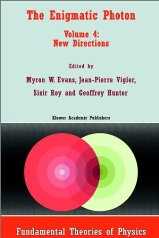 View count:
View count: 1
This volume establishes the fact that electrodynamics is by no means a completely understood theory by bringing together several in-depth review papers from leading specialists. The major portion of the volume is built around the nonlinear structure which leads to the B(3) field introduced in the previous three volumes published. Audience: Specialists, graduate and senior undergraduate students in physics, chemistry and electrical engineering.
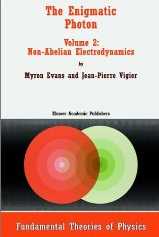 View count:
View count: 1
This book is a sequel to The Enigmatic Photon. Volume 1: The Field B(3) (Kluwer Academic Publishers, 1994), which presented the first systematic development of the fundamental magnetizing field of electromagnetic radiation: the field B(3). Its 12 chapters collectively describe the properties of B(3) in a vacuum and in the interaction of light with matter. The present volume deals with the development of the theory of the Evans--Vigier field B(3). It opens with the derivation of the novel field B(3) from the Dirac equation of relativistic quantum field theory. The existence of B(3) in the vacuum means that the gauge group of electromagnetism becomes 0(3), the group of rotations. This is non-Abelian, and so requires a self-consistent development of the vacuum Maxwell equations themselves. The role of B(3) is discussed in unified field theory and quantum electrodynamics. The classical vacuum field B(3) is a novel, fundamentally important feature of electrodynamics which indicates that the particulate photon carries mass, thus settling a longstanding debate in favour of protagonists of photon mass. For researchers and graduate students interested in the theory of electromagnetic radiation.
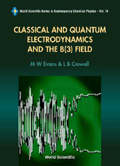 View count:
View count: 1
It is well known that classical electrodynamics is riddled with internal inconsistencies springing from the fact that it is a linear, Abelian theory in which the potentials are unphysical. This volume offers a self-consistent hypothesis which removes some of these problems, as well as builds a framework on which linear and nonlinear optics are treated as a non-Abelian gauge field theory based on the emergence of the fundamental magnetizing field of radiation, the B(3) field.
Contents:
- Interaction of Electromagnetic Radiation with One Fermion
- The Field Equations of Classical O(3)b Electrodynamics
- Origin of Electrodynamics in the General Theory of Gauge Fields
- Nonlinear Propagation in O(3)b Electrodynamics: Solitons and Instantons
- Physical Phase Effects in O(3)b Electrodynamics
- Quantum Electrodynamics and the B(3) Field
- Quantum Chaos, Topological Indices and Gauge Theories
- Field Theory of O(3)b QED and Unification with Weak and Nuclear Interactions
- Potential Applications of O(3)b QED
- Duality and Fundamental Problems
Readership: Graduate and undergraduates in physics (electromagnetism), differential geometry & topology, electrical & electronic engineering, theoretical & physical chemistry, chaos and dynamical systems.
"? beginners may benefit from the exhaustive references to the literature of contemporary workers in the field." -- Zentralblatt MATH
 View count:
View count: 1
by Myron W. Evans
Pages: 2375
Publisher: John Wiley & Sons
Year: 1994/2001
ISBN: B000VRLF42
Modern Nonlinear Optics serves as an updated, second edition of volume 85 of the series Advances in Chemical Physics. Utilizing the research of world-renowned experts, Modern Nonlinear Optics presents a dialogue between two prevailing schools of thought: one concerned with quantum optics and Abelian electrodynamics, the other with the emerging subject of non-Abelian electrodynamics and unified field theory. The prevailing paradigm?the Maxwell Heaviside theory?is developed in fields such as quantum optics, antenna theory, and holography, but it is also challenged using general relativity, O(3) electrodynamics, superluminal effects, and several other theories. This wide spectrum of opinion is presented so that a consensus can emerge. In addition, Modern Nonlinear Optics surveys developments over the last ten years, including advances in light squeezing, single photon optics, phase conjunction optics, and laser technology. It reviews thousands of papers emerging from both schools of thought and provides the most up-to-date and complete coverage available.
From the Publisher
International contributors present a comprehensive cross section of the state of the art as it stands today. These volumes feature review articles by the Poznan School and associated laboratories, as well as a selection of reviews contributed from many of the leading laboratories around the world in the various fields of nonlinear optics. Contains a wealth of illustrations.
 View count:
View count: 1
Volume 1 presents the first systematic development of the fundamental magnetizing field of electromagnetic radiation: the field B3. The book has 12 chapters which collectively describe the properties of B3 in a vacuum and in the interaction of light with matter. Volume 2 deals with the development of non-Abelian, or O(3), electrodynamics in which B3 is incorporated systematically. For researchers and graduate students interested in the theory of electromagnetic radiation.
 View count:
View count: 1
by Myron W. Evans
Pages: 2298
Publisher: John Wiley & Sons
Year: 1993/1997
ISBN: 0471184462
ISBN: 978-0471184461
ISBN: 0471304999
ISBN: 978-0471304999
ISBN: B000ML74D8
Now in paperback, each self-contained part of this special topics volume in the prestigious Advances in Chemical Physics series presents key research in nonlinear optics using a stimulating, broadly instructive approach. Includes extensive literature citations. -- Provides a comprehensive cross section of the state-of-the-art in this field.
From the Publisher
International contributors present a comprehensive cross section of the state of the art as it stands today. These volumes feature review articles by the Poznan School and associated laboratories, as well as a selection of reviews contributed from many of the leading laboratories around the world in the various fields of nonlinear optics. Contains a wealth of illustrations.
State-Selected and State-to-State Ion-Molecule Reaction Dynamics Part 1: Experiment Edited by Cheuk-Yiu Ng and Michael Baer "It contains a wealth of technical detail and experience and is a must for anyone using, or contemplating using, position-sensitive detection methods." Chemical Engineering Science Illustrated with eight in-depth studies, which shed light on the key experimental work being done in the field today, Part 1 of State-Selected and State-to-State Ion-Molecule Reaction Dynamics is a well-organized look at the experimental side of this highly useful and emerging chemical specialty. Part 1s progressive coverage includes: a comprehensive review of the theory and application of inhomogeneous rf fields; the application of multiphoton ionization for the preparation of reactant ion states; the conceptual and practical aspects of a multicoincidence technique; and the experimental results obtained using the photoionization and differential reactivity methods. 1992 (0-471-53258-4) 704 pp. State-Selected and State-to-State Ion-Molecule Reaction Dynamics Part 2: Theory Edited by Michael Baer and Cheuk-Yiu Ng Using clear illustrative examples culled from up-to-date research, Part 2: Theory makes the theory fundamental to state-to-state reaction dynamics not only understandable, but relevant to every day experimental work. Focusing exclusively on the theory of charge transfer processes during an atom (ion)-molecule (ion) collision, the book examines the different attitudes for treating the potential energy surfaces which govern the motion of the interacting atoms and ions and the reaction dynamics of these particles. The book also uses a variety of approaches, from the pure quantum mechanical approach, various semiclassical approaches to several statistical approaches, to address key issues in reaction dynamics. 1992 (0-471-53263-0) 576 pp. Advances in Chemical Physics Volume 84 Edited by I. Prigogine and Stuart A. Rice Volume 84 of this heralded series offers readers a detailed, up-to-date look at a host of important issues in chemical physics, including: the collisional time-correlation function approach to molecular energy transfer; molecular theory of liquid phase vibrational energy relaxation; electron degradation in molecular substances; and simulation of nonlinear electronic spectroscopy in the condensed phase. 1993 (0-471-58726-5) 560 pp.











